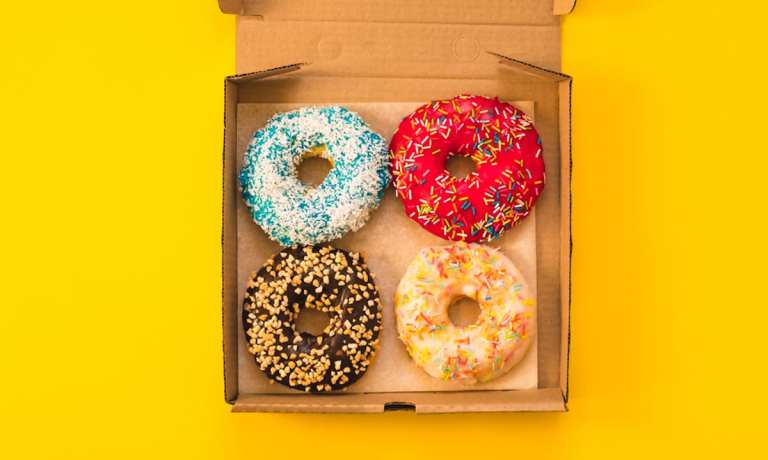
In the first round of lockdowns in March 2020, the food service industry experienced a massive shakeup. As consumers stayed indoors, establishments closed up shop temporarily or permanently, and furloughs and layoffs became the norm. Meanwhile, amid the anxiety and grief, many consumers were looking for safe ways to bring a little joy back into their lives.
Against this landscape, Michael Milton and Gabrielle Henning, a couple who had recently lost their food service jobs, started Pandemic Donuts, a doughnut delivery service based in Denver, Colorado. They began selling from home and advertising doughnuts via Instagram, operating under the state’s Cottage Foods Act. Now, the bakery has a commercial kitchen and a fully operational website, but the company’s social media-centric approach still drives its growth.
“So the way we’re set up … is we use our Instagram to market directly to our clients, communicate our day-to-day routines, show them that we’re human, show them we make mistakes, build … a grassroots, real connection with our clientele,” Milton told PYMNTS in a recent interview. “And then we push our clientele to our website through our Instagram.”
Building Through Social Media
The company’s Instagram page currently has over 10,000 followers, and Milton said the bakery can “reach up to 80,000 people per post through saves and shares.” To build this audience, Milton and Henning started giving free doughnuts to 20-30 food bloggers in the Denver area, which, Milton said, “gave us our first maybe 300 or 400 followers. From that point, it was more just word of mouth, and keeping the product as high quality as we could, and, yeah, lots of pretty Instagram pictures.”
From there, a local news outlet covered the bakery, which grew its followers into the thousands. “We didn’t do very much paid-for advertising,” Milton recalled. Soon, the company had so much demand that it was selling out for the week almost as soon as orders were posted, though Milton noted that things have now stabilized.
Though the company now has a somewhat more typical setup, operating out of a commercial bakery and taking orders through its website, the Instagram-native brand still brings in most of its sales through the social media platform, attracting attention by creating very social-friendly doughnuts. As Milton explained: “We’re able to have a lot of fun with flavors and colors, which helps on a platform like Instagram which is … less verbal, more visual.”
Turning The Struggle Into The Story
As is evident in its name, Pandemic Donuts did not find success in spite of the pandemic, but at least in part because of it, building difficult circumstances into the story of the brand. Milton explained that in building the staff, he and Henning focused on hiring local foodservice professionals who were out of work.
“I think that story, and our clientele being able to support a company that’s local and support people who were out of work, is a big part of [what our customers are looking for],” said Milton. “So I think it’s a combination of our really good products … and the community support aspect.”
Additionally, the business model was built around customers’ changing lifestyles. “As lockdown increased, people turned to their phones more … and people are ordering groceries more … they’re working from home a lot more, they’re learning from home a lot more,” Milton explained.“So as a bakery, what can we do to fit into that lifestyle better? For us, that’s been delivery.”
Making The Independent Delivery Model Work
The delivery-centric model can be difficult for an independent business to pull off, whether said business is partnering with a third party or delivering in-house. Pandemic Donuts opted for the latter. As Milton calculated, “Running the numbers, it’s cheaper for me to buy labor and a delivery car than it is to use a third party where they take 10 percent off the top all day.”
To make the model profitable, the bakery remains fairly conservative in its expansion. It currently serves six ZIP codes, adding new areas only when the team is confident that there will be enough demand to keep delivery stops very close together. Looking ahead, the company plans to add at most one ZIP code every two to three months.
“Within these ZIP codes, if we can keep our deliveries no more than five minutes apart, I’m able to pay my staff a pretty good hourly wage, I can pay for their gas, and we can keep it profitable,” said Milton. “We don’t have a delivery fee. Our doughnuts are on the higher end of the price, so delivery is kind of built into the price.”
As he reflected, “Delivery is tricky, and I don’t know if there’s a perfect way to do it. For us, it’s just delivering ourselves.”